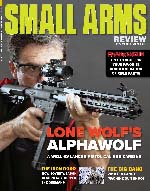The Iron Door: Soviet Russian Weapons Designers Stop the Germans in Their Tracks
By Terry Edwards
“You only have to kick in the door and the whole rotten structure will come crashing down…”
-Adolph Hitler
With this prediction, Hitler launched Operation Barbarossa, his invasion of the Soviet Union, on Sunday morning, June 22, 1941.
In four months, his army carved hundreds of miles east from Poland, through Russia, to the city of Tula. Tula straddled the roads and rails 120-miles south of Moscow and blocked the advancing Panzers’ path to victory. On October 29, 1941, Tula was now the door to Moscow.
Late in the 1500s, Tsar Fyodor I first settled gun-makers in Tula near the iron ore deposits by the Upa River. In the years that followed, Tula courted foreign gunsmiths and engineers to the city, and it became the center of Russian iron working and armaments. Peter the Great visited in 1712 and founded the state armory. By 1720, more than 1000 workers were producing 20,000 muskets a year. Tula gained a reputation for high-quality arms, often with ornate decoration, but the meat and potatoes continued to be military guns, like the Berdan rifles produced beginning in 1879. It was a city built by iron.
Arms production for the Russo-Japanese War of 1904–1905 and WWI swelled Tula still more. Most of the guns used in the Red Revolution and the fighting to follow came from Tula. When Hitler attacked, the City of Tula had a population of 272,000.
Hitler had confidently declared Russia would be defeated in three months. He was sure the Red Army would crumble if they lost the western industrial and agricultural heartland. An eastward retreat would be a suicide march into the wilderness. Hitler’s blazing victory would be so swift that no winter clothes for the troops, anti-freeze or low-temperature oils for engines and guns need be considered.
To Hitler the invasion of Russia was inevitable. It was Germany’s destiny and his to lead it. Communism was the mortal enemy of National Socialism and, moreover, the lands to the east were vital to a German future. There was no other choice.
This article first appeared in Small Arms Review V22N9 (November 2018) |
| SUBSCRIBER COMMENT AREA |
Comments have not been generated for this article.




